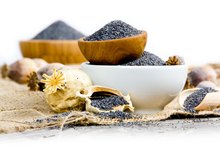Cayenne Pepper & Olive Oil for Arthritis
Arthritis, or joint inflammation, occurs in several different forms, with the most common type, osteoarthritis, affecting 20 million people in America, according to the University of Maryland Medical Center. The mainstay of arthritis treatment is non-steroidal anti-inflammatory medication, or NSAIDs such as ibuprofen, aspirin or naproxen. Alternative treatments for arthritis might appeal to you, if you suffer from side effects such as stomach upset when taking NSAIDs. Cayenne pepper and olive oil are two supplements which may have some benefit in treating osteoarthritis.
Doses
You can find cayenne pepper as oral capsules, with the usual dose being between 30 and 120 mg three times a day. Apply cream containing between 0.025 and 0.075 percent capsaicin to the painful area four times a day. Olive oil can be a part of your diet -- substitute olive oil for other types of cooking oils in salads and other dishes.
Cayenne Pepper Benefits
The Benefits of Habanero Pepper & Cayenne
Learn More
Cayenne pepper contains capsaicin, used as a spice, and as an oral or topical medication by Native American and Asian cultures. Capsaicin’s topical effects occur because applications of the drug to the painful area depletes substance P, a chemical found in the skin that carries pain signals to the brain. Capsaicin is used to treat both osteoarthritis and rheumatoid arthritis. Pain may increase with the first several treatments, due to stimulation of substance P; pain relief may take three to seven days
- Cayenne pepper contains capsaicin, used as a spice, and as an oral or topical medication by Native American and Asian cultures.
- Capsaicin’s topical effects occur because applications of the drug to the painful area depletes substance P, a chemical found in the skin that carries pain signals to the brain.
Olive Oil Benefits
A study that appeared in the September 2005 issue of “Nature” conducted by researchers from the University of Pennsylvania and the Monell Chemical Senses Center looked at olive oil’s similarity to NSAIDs. The study found that oleocathin, a substance found in olive oil, has similar properties to NSAIDs in inhibiting Cox-1 and Cox-2 enzymes, which can cause chronic inflammation. The Mediterranean diet, which uses large amounts of olive oil in food preparation, may reduce inflammation and benefit those with arthritis in similar ways to omega-3 fatty acids, which are known to decrease inflammation.
- A study that appeared in the September 2005 issue of “Nature” conducted by researchers from the University of Pennsylvania and the Monell Chemical Senses Center looked at olive oil’s similarity to NSAIDs.
- The study found that oleocathin, a substance found in olive oil, has similar properties to NSAIDs in inhibiting Cox-1 and Cox-2 enzymes, which can cause chronic inflammation.
Risks
How to Remove Capsaicin From Skin
Learn More
Cayenne pepper can sting the eyes and skin when used in the cream form. Do not touch the eyes or broken skin after applying capsaicin cream. Oral capsaicin can irritate the stomach or cause stomach ulcers. Heat can burn your skin after cream application -- don’t use heating pads, or take a hot bath or shower right after application. Cayenne pepper has crossover allergic reactions to other substances. If you have an allergy to latex, avocado, bananas, chestnuts or kiwi, do not take cayenne pepper. Because capsaicin can increase stomach acidity, don't use cayenne if you are taking stomach acid reducers. Capsaicin can also increase the risk of bleeding in people who take blood thinners or have bleeding disorders. Do not use cayenne pepper without discussing its use with your medical practitioner. The only risk to olive oil consumption is that olive oil contains about 120 calories per tablespoon, so watch your intake if you’re dieting.
- Cayenne pepper can sting the eyes and skin when used in the cream form.
- Because capsaicin can increase stomach acidity, don't use cayenne if you are taking stomach acid reducers.
Related Articles
References
- University of Rochester Medical Center, Health Encyclopedia: Cayenne
- Harvard Medical School, Harvard Women's Health Watch, "The dubious practice of detox." May 2008
- Reinbach HC, Smeets A, Martinussen T, Møller P, Westerterp-plantenga MS. Effects of capsaicin, green tea and CH-19 sweet pepper on appetite and energy intake in humans in negative and positive energy balance. Clin Nutr. 2009;28(3):260-5. DOI:10.1016/j.clnu.2009.01.010
- National Institutes of Health, Office of Dietary Supplements, "Dietary Supplements for Weight Loss, Fact Sheet for Health Professionals."
- Esmaillzadeh A, Keshteli AH, Hajishafiee M, Feizi A, Feinle-bisset C, Adibi P. Consumption of spicy foods and the prevalence of irritable bowel syndrome. World J Gastroenterol. 2013;19(38):6465-71. DOI:10.3748/wjg.v19.i38.6465
- Gagnier JJ, van Tulder M, Berman B, Bombardier C. Herbal medicine for low back pain. Cochrane Database Syst Rev. 2006 Apr 19;(2):CD004504.
- McCarty MF, DiNicolantonio JJ, O'Keefe JH. Capsaicin may have important potential for promoting vascular and metabolic health. Open Heart. 2015 Jun 17;2(1):e000262.
- Kim CS, Kawada T, Kim BS, et al. Capsaicin exhibits anti-inflammatory property by inhibiting IkB-a degradation in LPS-stimulated peritoneal macrophages. Cell Signal. 2003 Mar;15(3):299-306.
- Laslett LL, Jones G. Capsaicin for osteoarthritis pain. Prog Drug Res. 2014;68:277-91.
- Leung FW. Capsaicin as an anti-obesity drug. Prog Drug Res. 2014;68:171-9.
Writer Bio
A registered nurse with more than 25 years of experience in oncology, labor/delivery, neonatal intensive care, infertility and ophthalmology, Sharon Perkins has also coauthored and edited numerous health books for the Wiley "Dummies" series. Perkins also has extensive experience working in home health with medically fragile pediatric patients.









